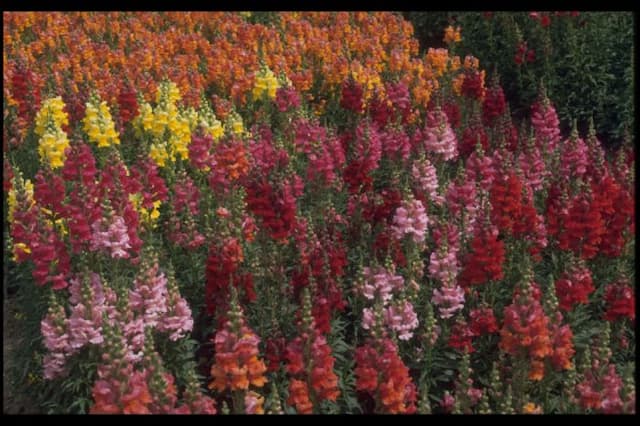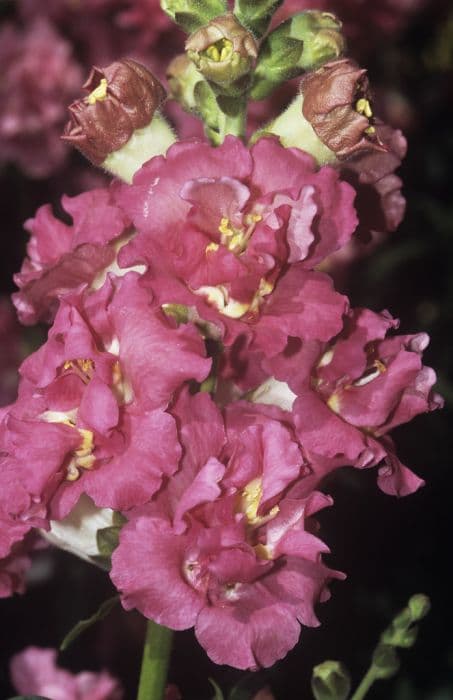Beardtongue Penstemon 'Red Riding Hood' (PBR) (Riding Hood Series)

ABOUT
Penstemon 'Red Riding Hood', commonly known as Beardtongue, is a vibrant perennial that is admired for its striking floral display. The plant features dense spikes of tubular flowers, notable for their vivid red hue that seems to attract hummingbirds and butterflies, creating a buzz of activity in the garden. The blossoms, with their bold color, rise elegantly above the foliage on sturdy stems, adding a touch of drama to any planting. The leaves of Beardtongue are narrow and lance-shaped, creating a lush backdrop for the fiery flowers. They are often a deep green color, and their arrangement along the stem is such that they provide a visual contrast that further accentuates the blooms. The foliage can also provide a subtle texture to the plant, adding to its overall aesthetic appeal. Penstemon 'Red Riding Hood' provides a burst of color that can enliven garden borders, rockeries, or container plantings. Its flowers not only contribute to the visual appeal but also serve as a valuable nectar source for pollinators during their blooming period. This Beardtongue variant is celebrated for its ease of growth and ability to bring a pop of color to a variety of garden settings.
About this plant
 Names
NamesSynonyms
Beardtongue, Red Riding Hood Beardtongue, Red Riding Hood Penstemon.
Common names
Penstemon 'Red Riding Hood' (PBR)
 Toxicity
ToxicityTo humans
The Penstemon, commonly referred to as 'Red Riding Hood', is not known to be toxic to humans. There are no well-documented cases or significant research indicating that this plant has any major toxins that affect human health. Therefore, accidental ingestion of small amounts is unlikely to cause symptoms of poisoning or significant adverse health effects. Nevertheless, it’s always advisable to exercise caution and avoid consuming plants that are not meant for human consumption, as individual reactions can vary.
To pets
Penstemon 'Red Riding Hood' is not considered toxic to pets, including dogs and cats. It does not contain known toxic compounds that would cause symptoms of poisoning in pets. However, ingestion of plant material by pets can sometimes lead to mild gastrointestinal upset due to the novelty and fiber content rather than toxicity. This can manifest as vomiting or diarrhea but typically is not severe. As with any non-food item, it is still best to prevent pets from ingesting plants to avoid any potential stomach discomfort.
 Characteristics
CharacteristicsLife cycle
Perennials
Foliage type
Deciduous
Color of leaves
Green
Flower color
Red
Height
1-2 feet (30-60 cm)
Spread
1-1.5 feet (30-45 cm)
Plant type
Herb
Hardiness zones
3-8
Native area
North America
Benefits
 General Benefits
General Benefits- Attracts Pollinators: Penstemon Red Riding Hood is particularly attractive to bees and hummingbirds, enhancing pollinator presence in gardens.
- Drought Tolerant: Once established, it requires minimal watering and can thrive in dry conditions, making it suitable for water-wise gardens.
- Long Blooming: It has a lengthy blooming period, often from late spring to early fall, providing long-lasting color in the garden.
- Low Maintenance: It is known for being easy to care for, with limited needs for fertilization or pruning.
- Deer Resistant: The plant is generally not a preferred choice for deer, contributing to its survivability in areas with deer populations.
- Colorful Foliage: Beyond its flowers, some varieties have attractive foliage that adds visual interest even when the plant is not in bloom.
- Versatile Use: Suitable for perennial borders, rock gardens, and wildflower meadows, as well as for use in containers.
- Soil Adaptability: Adapts to a variety of soil types, though it prefers well-draining soils.
- Cold Hardy: It is able to withstand colder temperatures, making it suitable for temperate climates.
 Medical Properties
Medical PropertiesThis plant is not used for medical purposes.
 Air-purifying Qualities
Air-purifying QualitiesThis plant is not specifically known for air purifying qualities.
 Other Uses
Other Uses- Penstemons can be used for attracting hummingbirds to your garden as they are drawn to the bright red flowers for nectar.
- Their colorful blooms can be used to make natural dyes for fabrics or crafts, capturing shades of red and pink depending on concentration.
- Dried penstemon flowers can be incorporated into potpourri mixes for a natural, subtle fragrance and for decorative purposes.
- When planted in masses, they can be utilized for erosion control on slopes because of their root structures.
- Penstemon flowers can be used as a natural food source for pollinators, including bees and butterflies, promoting biodiversity.
- These plants can be incorporated into sensory gardens, as they provide interesting textures and colors to touch and see.
- Penstemons can be used in xeriscaping, a landscaping style that requires minimal irrigation, as they are drought-tolerant once established.
- They can also serve as a living mulch, suppressing weeds and retaining soil moisture when planted closely together.
- Penstemon flowers can add visual interest to winter gardens, as some retain their seed heads, offering an architectural element once the blooms have faded.
- In educational gardens or botanical displays, penstemons can be used to demonstrate plant adaptation and pollination strategies.
Interesting Facts
 Feng Shui
Feng ShuiThe plant Beacon Red Penstemon is not used in Feng Shui practice.
 Zodiac Sign Compitability
Zodiac Sign CompitabilityThe plant Beacon Red Penstemon is not used in astrology practice.
 Plant Symbolism
Plant Symbolism- Attraction and Charm: The vibrant red flowers of Penstemon 'Red Riding Hood' symbolize the power to attract and captivate, much like the allure of the character Red Riding Hood from the fairy tale.
- Boldness: The bold red color signifies courage, strength, and a willingness to stand out, reflecting the bravery Red Riding Hood exhibits in her story.
- Vitality: The Penstemon's hardiness and long blooming season represent strong life force and good health.
- Balance: As Penstemons tend to be hardy and adaptable, they may represent the ability to balance multiple aspects of life.
 Water
WaterBeacon Bells Penstemon needs regular watering to maintain consistently moist soil, especially during the growing season. Aim to water this plant once or twice a week, depending on the weather and soil conditions. Be cautious not to overwater; ensure good drainage to avoid soggy soil which can lead to root rot. A good practice is to provide the plant with about one gallon of water per session, ensuring it reaches the root zone. During the hottest parts of the summer, you may need to increase watering frequency, while in winter, reduce it as the plant's water requirements decrease.
 Light
LightBeacon Bells Penstemon thrives in full sun to partial shade. It's best to place the plant in a location where it can get at least six hours of sunlight each day. However, in extremely hot climates, some afternoon shade is beneficial to prevent foliage from scorching.
 Temperature
TemperatureBeacon Bells Penstemon prefers a temperature range of 60 to 70 degrees Fahrenheit for optimal growth. It can tolerate a minimum temperature down to about 20 degrees Fahrenheit and a maximum temperature up to about 85 degrees Fahrenheit. The ideal growing conditions for this plant are a temperate climate with cool nights and warm days.
 Pruning
PruningPruning Beacon Bells Penstemon is crucial for promoting bushier growth and more flowers. Deadhead spent blossoms regularly to encourage continued blooming throughout the season. Perform a more thorough pruning in late winter or early spring to remove old, woody stems and to shape the plant. It's generally sufficient to prune this plant once a year during this time frame.
 Cleaning
CleaningAs needed
 Soil
SoilBeardtongue requires well-draining soil with a slightly acidic to neutral pH of 6 to 7. The best soil mix comprises equal parts of loam, sand, and peat to ensure good drainage and aeration.
 Repotting
RepottingThe Beardtongue doesn't need frequent repotting and should be repotted only when it outgrows its current container, typically every 2 to 3 years.
 Humidity & Misting
Humidity & MistingThe Beardtongue prefers average to low humidity and can tolerate dry air conditions, making it suitable for typical indoor environments with no special humidity requirements.
 Suitable locations
Suitable locationsIndoor
Place Beardtongue in bright indirect light, in well-draining soil.
Outdoor
Plant Beardtongue in sunny spot with well-drained soil.
Hardiness zone
4-9 USDA
 Life cycle
Life cyclePenstemon 'Red Riding Hood', commonly known as Beardtongue, begins its life cycle when seeds are sown in well-drained soil after the danger of frost has passed. The seeds germinate, and seedlings emerge, usually requiring warm temperatures for optimal growth. As they mature, the plants develop robust root systems and foliage, eventually producing tall spikes with vibrant red, tubular flowers by early to mid-summer, attracting pollinators such as bees and hummingbirds. After pollination, the flowers develop into small seed capsules, which release seeds when they mature, completing the reproductive cycle. With the onset of fall, the plant begins to die back, entering a period of dormancy during the colder months. If conditions are right, Penstemon 'Red Riding Hood' will re-emerge from its roots the following spring to start the cycle anew, although they may also be grown as annuals in some climates.
 Propogation
PropogationPropogation time
Spring-Early Summer
Propogation: Penstemon 'Red Riding Hood', commonly known as Beardtongue, is often propagated by stem cuttings, a popular and effective method for this perennial. The best time to take cuttings for propagation is in late spring to early summer, when the plant is in active growth. To propagate by stem cuttings, select a healthy, non-flowering stem and cut a 4-6 inch (approximately 10-15 cm) length, making sure there are at least a couple of leaf nodes present. Remove the leaves from the lower half of the cutting and dip the cut end into a rooting hormone to encourage root development. Insert the cutting into a pot filled with a well-draining soil mix, ensuring that at least one leaf node is below the soil surface. Water the cutting and keep it in a warm, brightly lit area, avoiding direct sunlight until roots have established, usually within a few weeks.





![Snapdragon [Pretty in Pink]](/_next/image?url=https%3A%2F%2Fplants-admin.emdemapps.com%2Fimages%2Fplants%2F%2Fimages%2F604b5cb3b5385.png&w=640&q=75)



